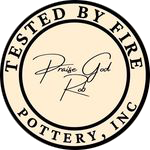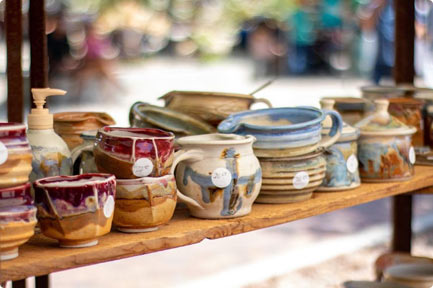Uncategorized
Why I Do What I Do: The Steps in making a piece of pottery
Step 5: Slip Trial Decoration
I put a slip trialed decoration on some of the pieces that I make. Slip trailing is done while the pottery is still moist because otherwise, the slip will not adhere to the piece. The slip I use is a watered-down porcelain clay. I use a porcelain body because it fires very white and is a good contrast to the clay body that I work with.
The slip is mixed in a blender to remove any lumps and inconsistencies and poured into a plastic bottle with a nozzle. To apply the slip, you squeeze the bottle as you move your hand over the leather hard clay piece. The blue bowl that is shown is an example of how the slip trailed porcelain shows through the glaze.
Step 6: Signing or Stamping the Signature
When I started making pottery, I hand-signed everything using a brush and mixture of iron oxide and bentonite clay that watered-down enough to flow from a brush. But when I started making larger numbers of pieces, I soon decided I needed to figure out a way to stamp my signature. The decision was precipitated by my mis-signing some pieces and not catching it until it was too late. The mis-signing led to considerable embarrassment for me. When you sign your work “Praise God Rob” it is not good when you discover that you have written “Praise God God” or, even worse,”Praise Rob Rob” instead. Fortunately, very few of these pieces made it into the hands of my customers. Even though I was embarrassed they weren’t willing to give them back or exchange them.
Step 7: Waxing After the pieces dry and the signature is applied then a coating of hot wax (paraffin) is applied to the bottom. The paraffin resist the glaze making it easier to clean. We glaze at this point because we single fire our pottery. Most potters do a bisque firing which is a firing without glaze. This generally is a firing that is lower temperature than the glaze firing. Some ceramics such as fine china is fired to a higher temperature in the bisque firing than the glaze firing. Years ago, I decided that I would single fire my pottery and save the money time and effort of the bisque firing. Unfortunately, the learning curve was long but I once I made up my mind to go that direction, I continued down that road. There was a great deal to learn, which included, how to glaze the brittle greenware and adjust my glazes to deal with the increased shrinkage during the single firing. I also had to learn how to extend the firing so that piece wouldn’t explode in the firing.

